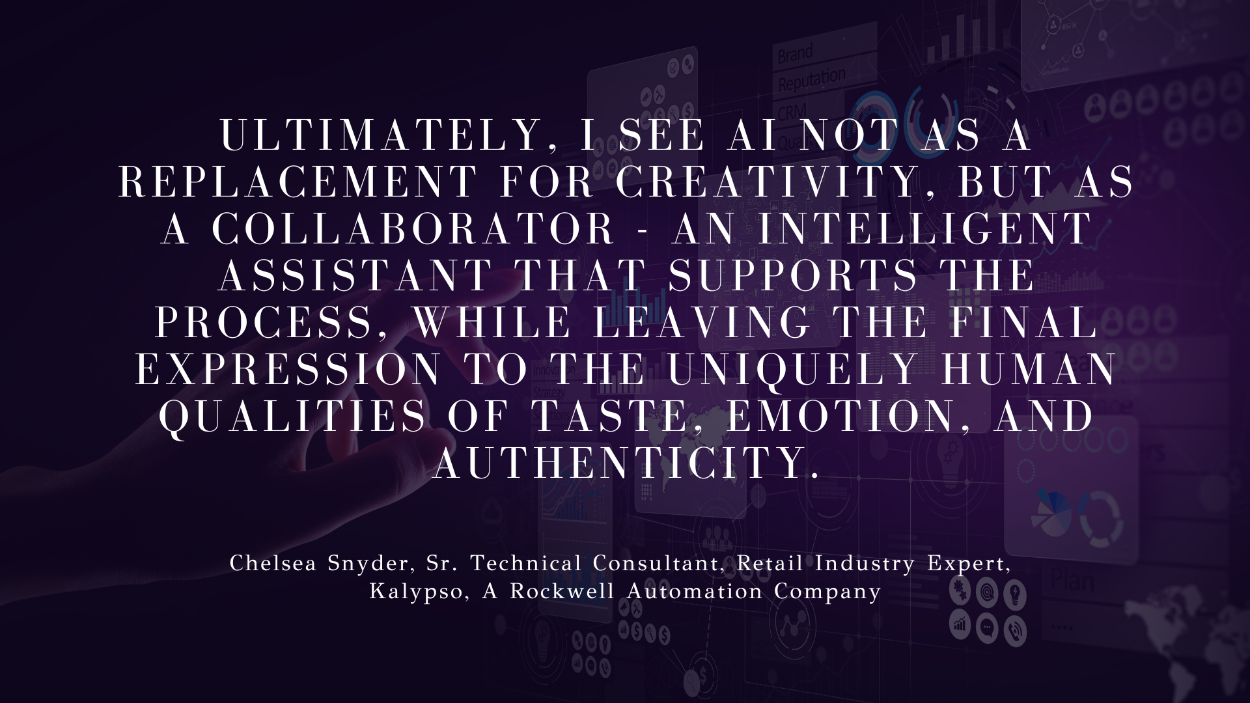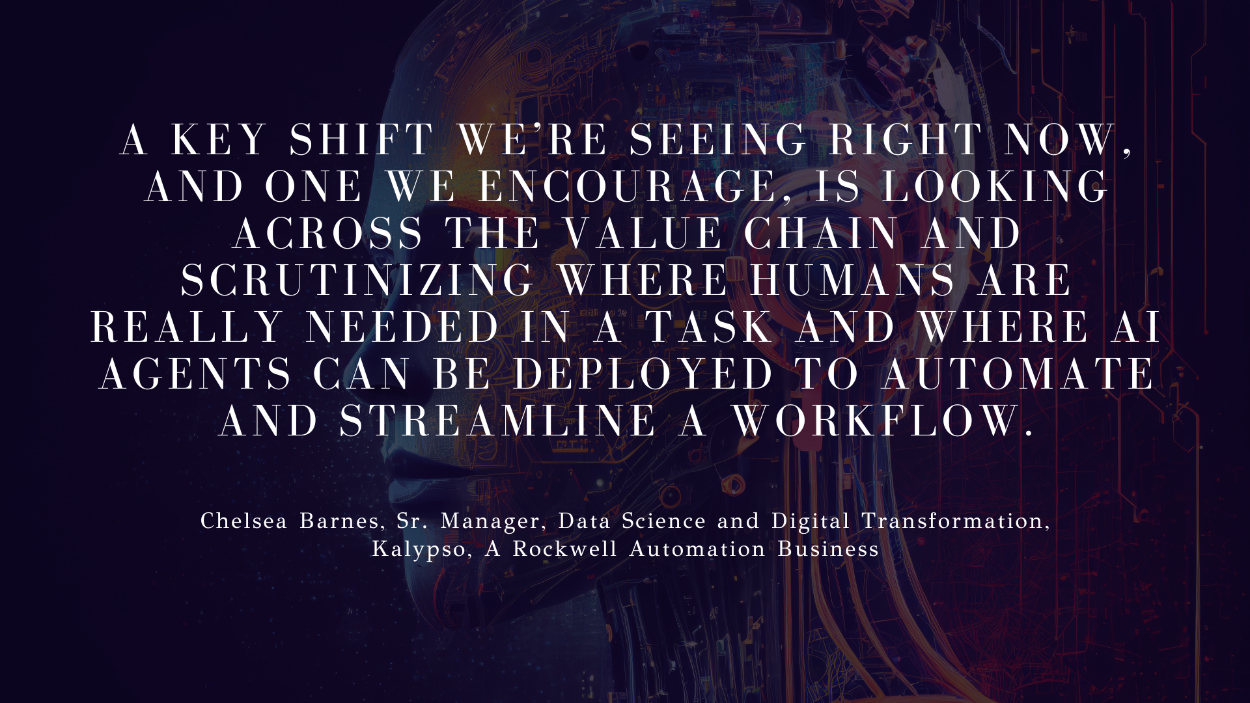Released in The Interline’s AI Report 2025, this executive interview with Kalypso is one of an eight-part series that sees The Interline quiz executives from companies who have either introduced new AI solutions or added meaningful new AI capabilities into their existing platforms.
For more on artificial intelligence in fashion, download the full AI Report 2025 completely free of charge and ungated.
Key Takeaways:
- AI adoption across fashion depends on foundational readiness. Functions like marketing have progressed quickly due to better data maturity, but design, merchandising, and quality remain limited by fragmented systems. Until brands invest in structured, integrated data, AI will struggle to deliver consistent, scalable business value.
- Barnes and Snyder advocate for a more intentional, end-to-end approach to AI implementation—starting with clear business pain points, focusing on low-friction use cases, and ensuring tools augment rather than displace human creativity. Strategic rollout, team involvement, and cultural alignment are key to ensuring AI enhances creative processes rather than distorting them.
- While generative AI captures attention, the broader opportunity lies in deploying a full spectrum of AI tools across backend operations. From inventory and planning to quality control, the emphasis should be on practical fit and long-term value creation. For both consumers and teams, thoughtful communication and gradual change management are essential to building trust and lasting adoption.
Where do you believe we currently are on the progression curve from AI as an extremely broad set of capabilities and promises, to AI as the foundation for applications and services that can deliver a measurable return on investment in well-defined areas?
Chelsea Barnes: The answer entirely depends on where in the value chain AI is being applied. If you think of AI’s use in brand outreach that’s a space with broad use, mature tools and proven ROI. However, when you consider other functions such as design, quality or merchandising, AI use is only now gaining momentum. The key difference between these groups is the availability of quality data. The “big data” functions of commercialization and marketing have had more to work with and for longer. Adoption has been slower for functions grappling with foundational data-readiness challenges.
Until brands invest in organizing and integrating their data, AI applications will struggle to produce insights or outputs that translate into sustainable business value. The promise is there, but the groundwork is still being laid.
Nobody will argue with the idea that fashion is a creative industry, but it’s fair to say that the processes of turning creative ideas into commercially-viable products that are manufacturable at scale have come to dominate the industry’s mindset, because those are the steps that could be quantified, controlled, and to some extent automated. Do you think AI changes that framing? Should we now be interrogating more complete, end-to-end workflows, applying the same scrutiny, and asking what AI can do to control and add value to a wider spectrum of processes and free creative professionals up to focus on the ones it can’t?
Chelsea Barnes: Absolutely. A key shift we’re seeing right now, and one we encourage, is looking across the value chain and scrutinizing where humans are really needed in a task and where AI agents can be deployed to automate and streamline a workflow.
Chelsea Snyder: Agree. Industry leaders are scrutinizing end-to-end workflows and finding real value in using AI to automate repetitive, low-value tasks that often consume the time and energy of creative professionals. By offloading those tasks, such as data formatting, trend tagging, or iterative variations, AI can free up space for designers and creatives to focus on the higher-order work: ideation, storytelling, and aesthetic decision-making.
Ultimately, I see AI not as a replacement for creativity, but as a collaborator – an intelligent assistant that supports the process, while leaving the final expression to the uniquely human qualities of taste, emotion, and authenticity.
Like with any hyped technology revolution, the possibility space with AI is seemingly so vast that there are solutions being actively sold in every conceivable category – and the temptation for brands surrounded by internal challenges and external pressures is to go after them all and to prioritise them according to some often pretty subjective criteria. What do you think is the right decision-making framework to use to make more grounded choices about which AI applications will actually translate into competitive advantage, and which ones will complement existing transformation initiatives like digital product creation?
Chelsea Snyder: In a space as saturated and fast-moving as AI, the key to making grounded, strategic decisions starts with clarity: clarity around the problem you’re solving, the maturity of the AI solution, and the measurable outcomes you expect. It’s not about chasing every opportunity. It’s about aligning AI initiatives with clearly defined business pain points and existing transformation goals.

A useful framework starts with identifying high-friction areas within core workflows – places where time is lost, where decision-making is delayed, or where creative energy is drained by repetitive tasks. From there, it’s important to vet AI solutions not just for their theoretical capability, but for their practical fit. Ask questions like: Can they integrate with existing systems? Can they be tested quickly in a contained pilot? Do they augment human value rather than add new layers of complexity?
In the case of digital product creation, the potential is enormous – shorter timelines, faster iteration cycles, and more responsive design processes. But as with many AI solutions, some tools are still maturing. Brands should approach these with curiosity and discipline, partner with vendors transparently, and continuously evaluate whether the tool is truly enabling creativity or unintentionally redefining the role of creatives in ways that may not align with their strengths or passions.
For a range of different reasons, fashion has become fixated on generative AI. This is why we see so many companies offering generative solutions to aid designers, or to replace product photography. For some – maybe many – companies these are no doubt areas where AI can deliver a quantifiable return, but they’re also the thin end of a much bigger wedge, and the emphasis that’s being placed on them perhaps hides the huge variety of different AI applications out there – from inventory management to quality control. How should brands and their partners be thinking about this much wider frontier?
Chelsea Snyder: Generative AI has captured attention because it’s visual, immediate, and easy to grasp, but it’s just one part of a much broader AI landscape. To unlock real, sustained value, brands need to step back and take a more holistic view. That starts with identifying their core operational challenges – whether it’s excess inventory, long lead times, quality inconsistencies, or inefficiencies in the supply chain – and mapping AI opportunities against those pain points.
Chelsea Barnes: Exactly. Once those opportunities are mapped, you can look at the right solutions to achieve the desired goals. Here are some questions to consider: Are there out-of-the-box tools to meet your company’s needs or is something custom needed? What kind of AI algorithm is best suited to the problem – does the output need to be more deterministic and explainable, making traditional ML a better fit, or is the need around information crunching or ideation, making Generative AI a better fit? What data and infrastructure is available to support these use cases?
With the clarity that comes from answering these questions, brands can feel confident the technology choices they’re making are right-sized for the problems to solve. The emphasis should be on feasibility, fit, and value creation, rather than getting distracted by what’s most visible or hyped.
As much as we’re talking about technology here, there are also two different cultural elements to consider when it comes to AI adoption: the ethics of consumers around AI in general, and how receptive internal audiences and teams are to specific tools. Each of those is likely to spill over into the other, making the next step on this journey as much about external communication as it is about internal change management. How do you think fashion companies should approach rolling out AI progressively and sensitively – in a way that avoids overwhelming teams or creating backlash amongst end users or consumers?
Chelsea Snyder: AI adoption isn’t just a technological challenge; it’s a cultural one. Fashion brands must treat it as such. Internally, it’s about change management and introducing AI in a way that empowers teams rather than overwhelms them. Externally, it’s about trust – communicating openly with consumers without overexposing sensitive or proprietary processes.
Transparency is key, but it needs to be thoughtful. Consumers don’t expect brands to reveal every detail of their workflows, but they do expect honesty about how technology is being used, especially when it touches creative output or customer experience. Brands should proactively shape the narrative, emphasizing that AI is a tool, not a replacement for human creativity. The final product should still reflect the emotion, intuition, and authenticity that define great design.
Internally, progressive rollout is essential. Start with use cases that remove friction, such as for repetitive, low-impact tasks, and involve teams early in the process. Make them collaborators, not just users. By demystifying the tools and clearly articulating their benefits, companies can reduce resistance and build internal champions.

Ultimately, this is about balance. It involves combining strategic transparency with strong internal alignment to build trust, maintain authenticity, and evolve responsibly. The brands that handle this well will be the ones that treat AI not just as innovation, but as a relationship with their teams and with their customers.
What do you believe are the next steps for how AI is deployed and used? Is it more likely that AI will solidify its place as a new human interface paradigm the frontend of tools and workflows? Or is its future closer to what cloud infrastructure has become today – a quieter commodity that is still the foundation for the next generation of applications, but in a less obvious way than what we’ve seen over the last couple of years? Or is it both?
Chelsea Barnes: AI is becoming both a new interface and a foundational layer, much like cloud infrastructure before it. On one hand, it’s increasingly visible in the tools we interact with every day. On the other, its deeper value will emerge through less visible, systemic enhancements that power efficiency and insight behind the scenes. That dual trajectory is what makes this moment both exciting and complex.
Chelsea Snyder: We’re also seeing a growing cultural counterbalance. As AI evolves, so does the desire to reaffirm and protect what is distinctly human. This tension is productive and forces brands to deploy AI with more thoughtfulness, not just speed. Success won’t come from adopting tools in isolation, but from embedding them into well-managed, human-centered systems.
To deploy AI progressively and sustainably, brands should focus on these next steps:
- Invest in training and literacy. Ensure teams understand not just what AI tools do, but how to use them efficiently. Educating teams helps avoid tool fatigue and builds long-term adoption.
- Prioritize change management. AI isn’t plug-and-play. Rolling out tools should include internal communication plans, pilot programs, and feedback loops to help people adapt at a manageable pace.
- Audit and align tech stacks. Evaluate how AI integrates into your existing systems—and how it affects (or replaces) legacy workflows. Stay proactive about evolving or retiring outdated tools.
- Designate AI ownership. Create roles or responsibilities within teams to track AI advancements, evaluate vendor updates, and translate technical shifts into business relevance.
- Balance visibility with value. Don’t only chase the flashiest AI use cases. Explore backend applications—like planning, logistics, and supply chain—that may be less visible but deliver massive ROI.
- Stay rooted in your brand’s human voice. Let AI do the heavy lifting, but ensure the final experience still feels authentic, emotional, and distinctly you.
